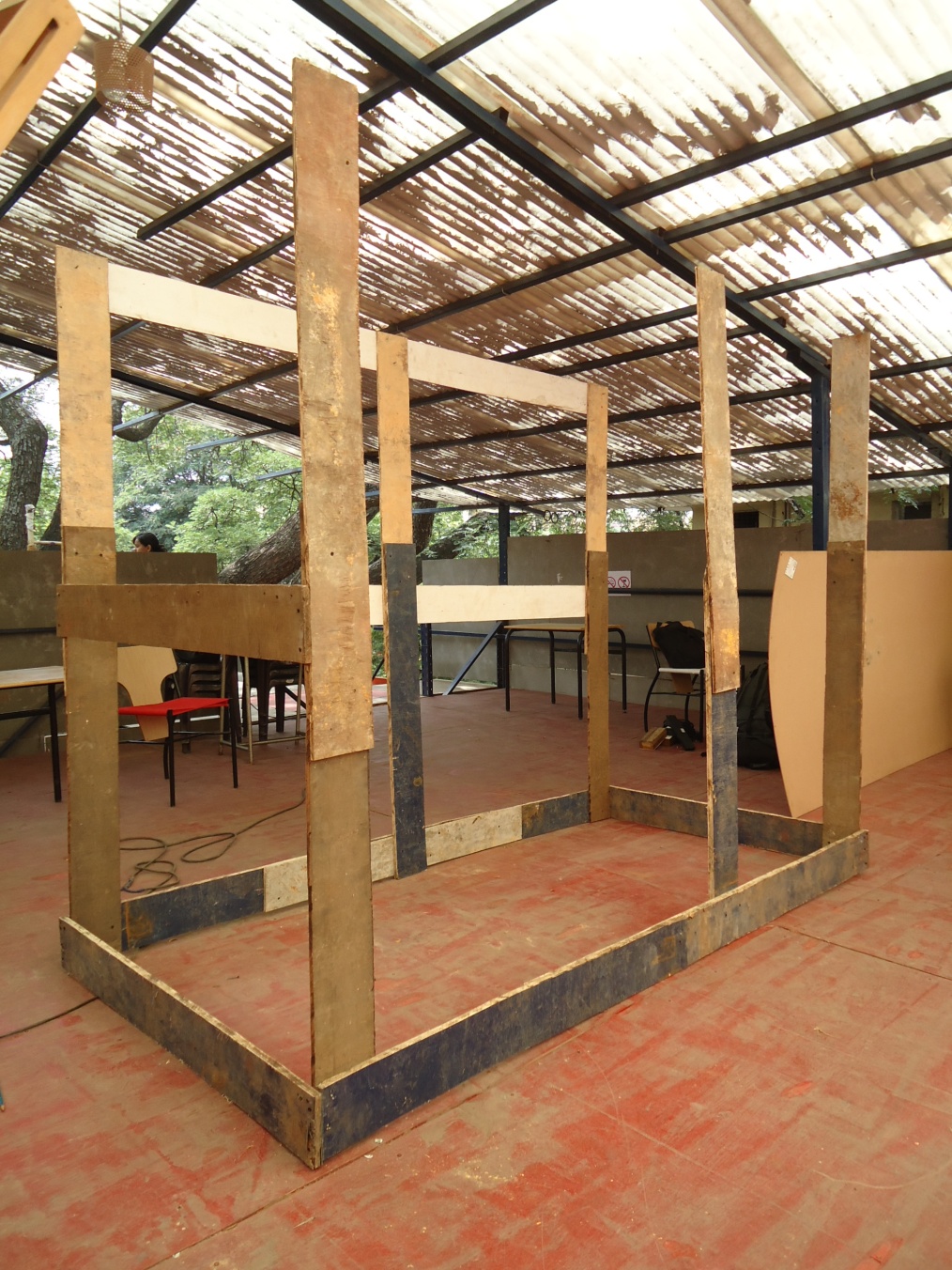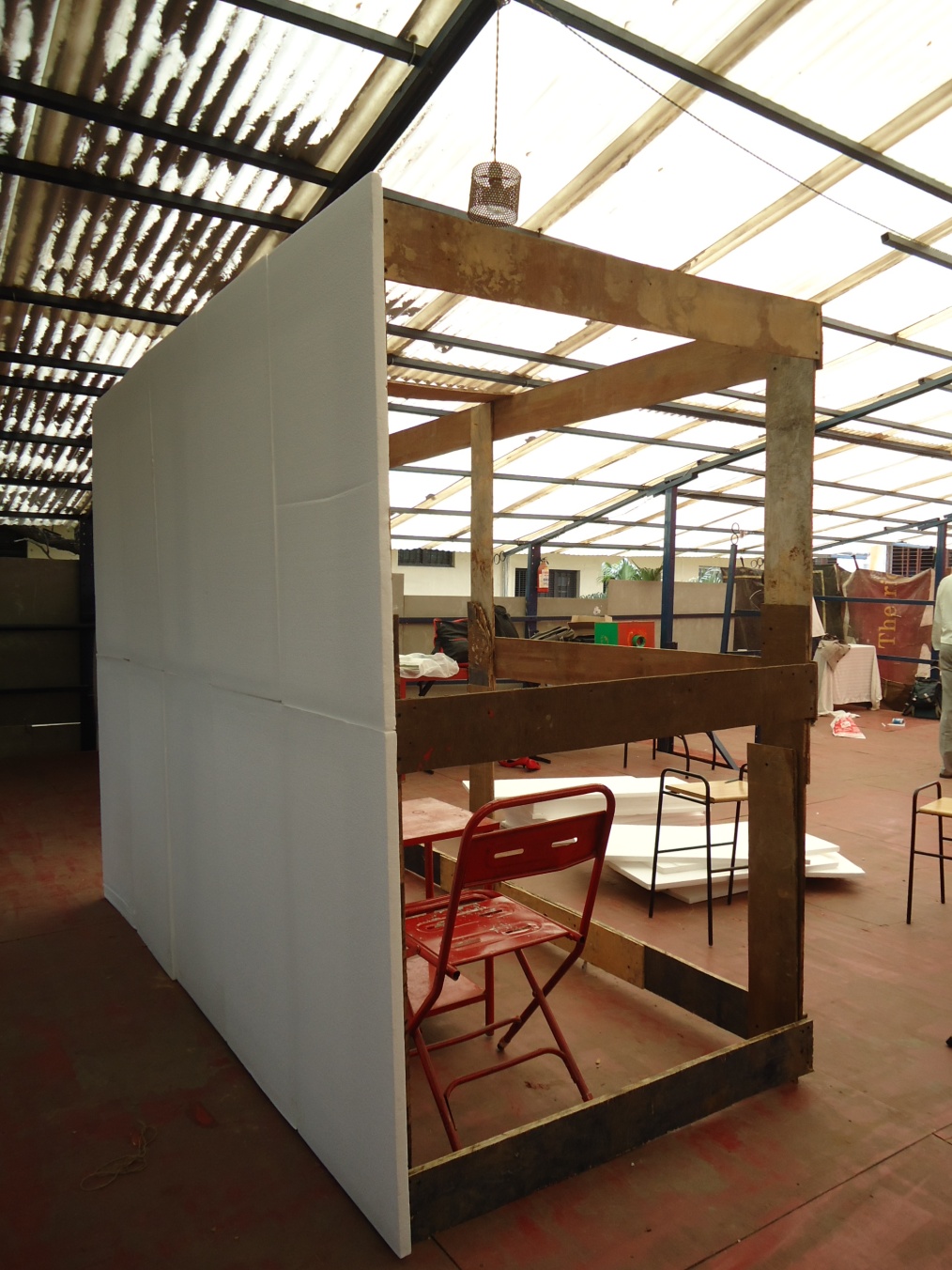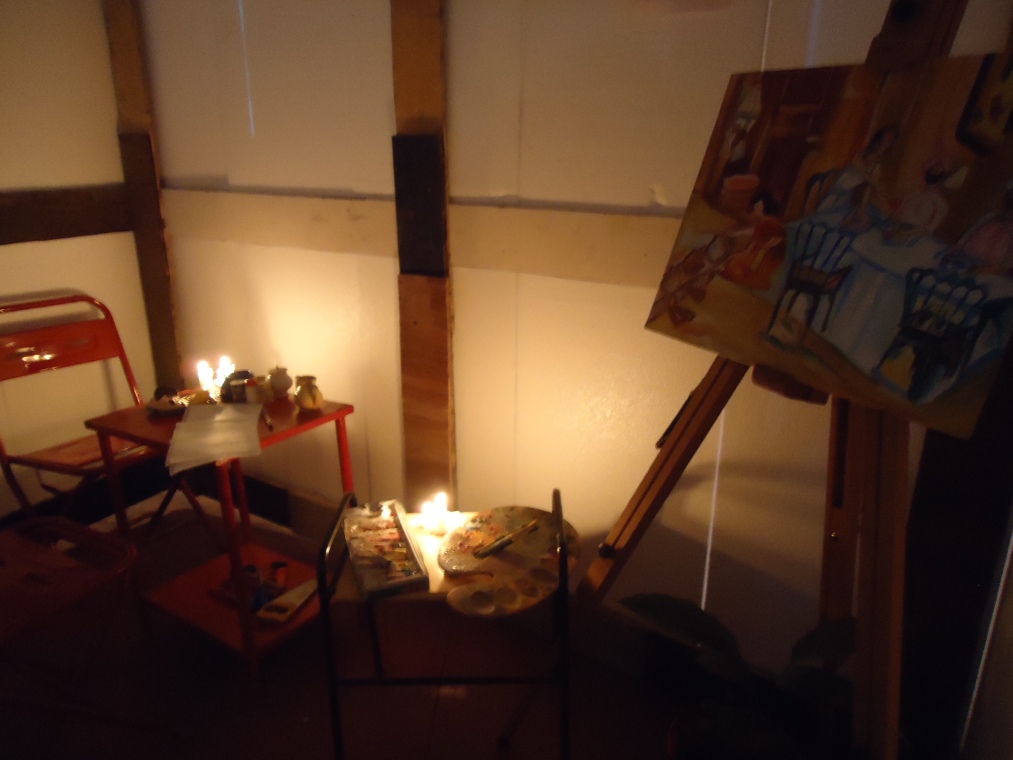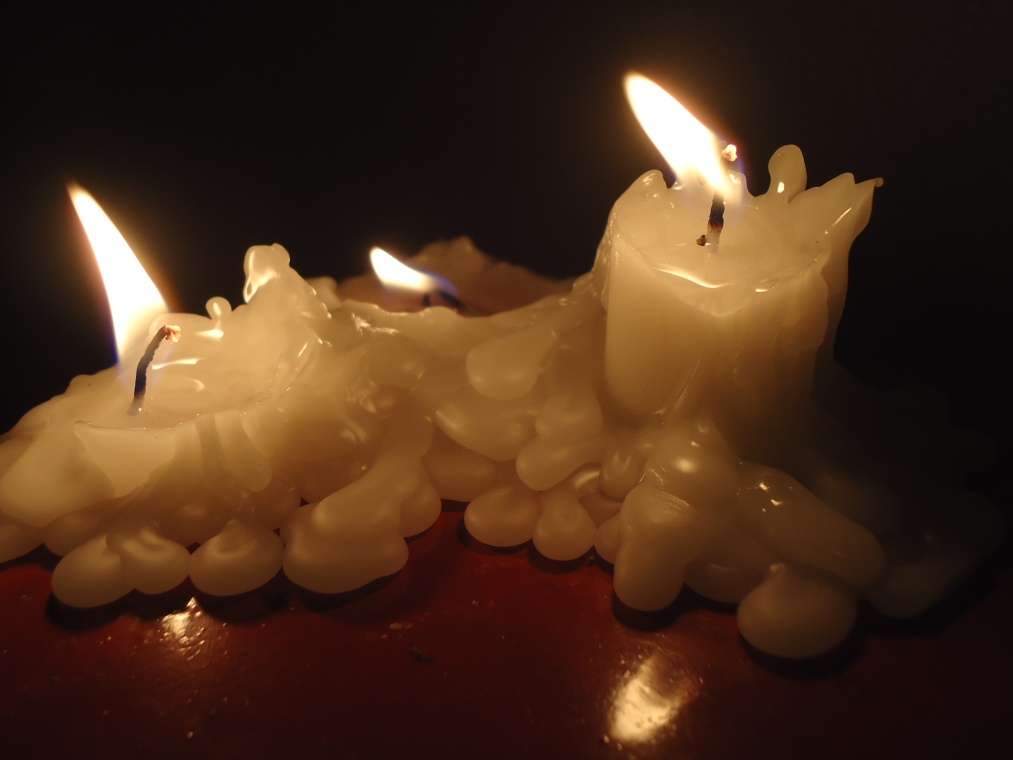
Category Archives: Art
ALBATROSS…A feeling for my work towards them!
On visiting the terracotta craft cluster based in Marasandra village which is almost 15 kilometers from the NES Quarters Yelahanka, I for the first time confronted the artisans who have spent their entire lives working in clay. I was eyeing the entire village on foot and observed that every second house was involved in terracotta work. All of them worked hard to make clay idols of deities and other human figures which had a particular season of sale (mostly during festivals). Most of them also worked on wheels where clay was thrown on to be molded into a pot.
I and two of my friends spent half a day with an aged potter who was working towards the fulfillment of an order of 600 plantation pots. The first thing that caught my attention the moment I saw him working was his physical form which was involved in the rigorous backbreaking work. Never had I seen a potter’s wheel which was hand drawn and never had I witnessed a 75 year old laboriously standing, throwing, applying momentum to the wheel and molding. The site was compassionate for the plight of the artisan. I with the help of my Kannadiga friend, tried to start a conversation with him making sure that his work is not caused any trouble. Our conversation started with momentary dialogues until the artisan was convinced and comfortable about the reason for our visit to his workplace. I was content to have the potter smiling and laughing with us by the end of our stay there. My conversations with the other potters and artisans in town also lead to the possibilities and reasons for the intervention that I intend to have.
I questioned mainly about the range of products produced by the artisans, their target audience or market and the quantity of items created within 11 hours of laborious work every day (6a.m. to 5 p.m.). On my enquiry, I discovered that the products were mainly produced to fulfill orders placed by dealers from the cities (mainly Bangalore). The range of products was mostly limited to one or two types of plantation pots, piggy banks, coal stoves and God idols. Out of these, God idols were mainly sold during festival seasons like Diwali, Dusshera and Navratri.
On questioning them about the non-innovation of products, they simply answered that the new products are not sold enough. The amount of time that is spent on doing the intricate and different style of work does not pay off because of less or no sale. One of the artisans, was greatly hopeless about the market for terracotta products. His opinion about the people who intended to intervene in this work was negative due to his past experiences. He felt that people come and go but never come back. He demanded long term development and was unhappy with short term earnings.
I felt that my role as a designer can only be justified not by producing good designs using the crafts but in reality marketing the products and opening huge market opportunities and creating demands for the craftsmen. The terracotta pots have also got a competition against the cement pots. It is important to expose the advantages of the natural materials used in the handicraft industry which renders them more eco-friendly and non-toxic as compared to the other products.
There are definitely a few artisans who have started developing contemporary products as a result of intervention but still, there exist a major percentage of craftsmen whose crafts are now endangered. Most of them have also started getting involved in other businesses like farming and construction. They work in terracotta only when they receive orders and during festivals.
The visit and conversations with these craftsmen have burdened me with a larger responsibility and a greater role as a person who can create work and better opportunities for them. I do not wish to let their confidence down and make them believe that anybody who comes just comes and goes away and never comes back. Indeed I am a little scared right now but at the same time I know that the first step will lead to the next.
Inborn Processing
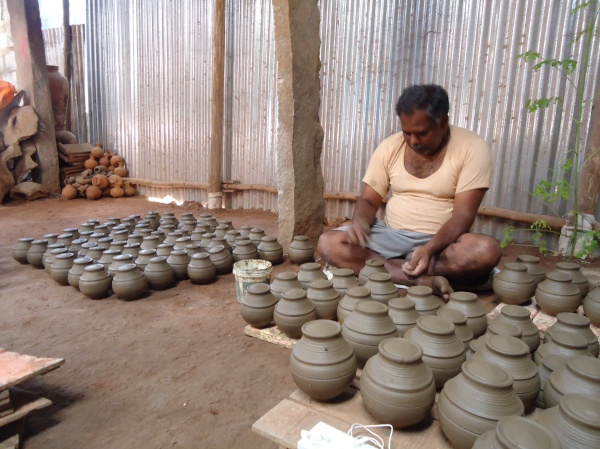
A terracotta craftsman working on his patent clay piggy banks. The product range is limited to various sizes of a single design piggy bank and God idols for various festivals.
Indigenous
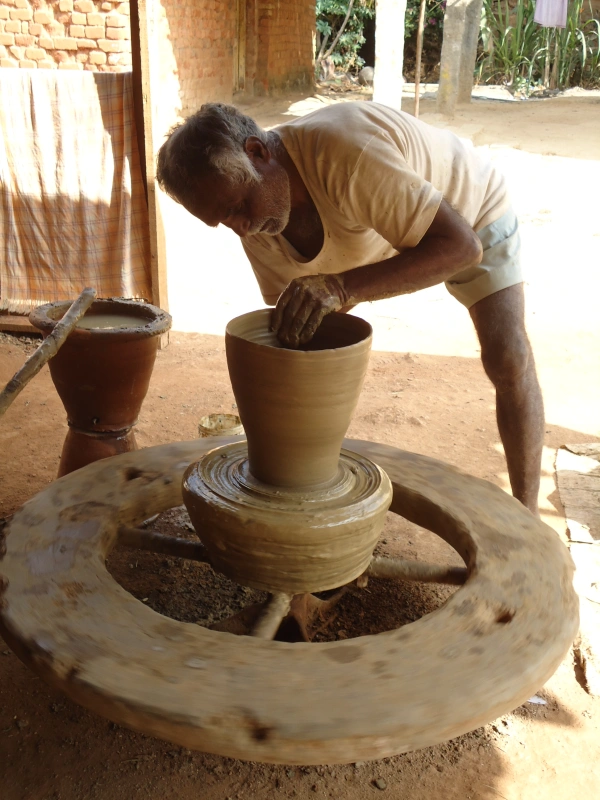
Potter working on his hand-turned wheel
Everything starts from a single point!

My sKetcHbooK Cover
THE COLORFUL INSIGHT
How colorful the life is now. This is what came to my mind the very first time those packets of colorful sand were placed in front of me. I went deeper into that thought and instantly it came to my mind what is it that makes my life so blissful. Some sort of a negative feeling has been dissipated from my life. Yes it has. My life now is what I wanted it to be – Self dependent.
Ever since in the workshop with Tahirey, we were given that material (colorful sand) to play and experiment with, I could only think of what I just mentioned.
We had to produce an artwork which talked about one of our own qualities or a part of our life which described or influenced us.
In my artwork, I portrayed me and my younger brother successfully coming out of a complex and dependant life of my house where the decisions for us were taken by the third generation elders instead of our own parents. I tried to show the problems that we faced due to the generation gap between us and our grand parents and how we conquered that and reached our goal of self driven behavior. I have carefully chosen the colors of the sand to demonstrate the state of the humans individually in that particular frame.
 As seen in the picture above, I used the yellow, green and blue colors to show mine, my brother’s and my parents’ life and aspirations. Full of greenery and regardless of ‘Stop’ as symbolized by the red which is the word and feeling that comes out of my grandparents life. Always a NO for any smallest of the things
As seen in the picture above, I used the yellow, green and blue colors to show mine, my brother’s and my parents’ life and aspirations. Full of greenery and regardless of ‘Stop’ as symbolized by the red which is the word and feeling that comes out of my grandparents life. Always a NO for any smallest of the things
 I used various sizes of the character symbolizing cylinders to portray the position of the person in the house. The longest red cylinder signifies my grandfather who always is against our thoughts and ideas – who probably has his own thinking which he expects today’s generation to follow.
I used various sizes of the character symbolizing cylinders to portray the position of the person in the house. The longest red cylinder signifies my grandfather who always is against our thoughts and ideas – who probably has his own thinking which he expects today’s generation to follow.
The middle-sized blue and yellow cylinders symbolize my parents who although have a higher position than us in the house, have a neutral say in the decisions for us – as suggested by their colors. But the fact is that they support us and know that we need to go ahead in life and face the world.
The other two smallest green cylinders – out of which one is even smaller symbolizing my younger brother, signify the ‘Go’ or willing to move ahead in life mindset. It shows they are away and won’t listen to the NOs and the IFs and BUTs.
I tried to show that how with the constant effort, we succeeded in moving ahead in life leaving behind all the negativeness.
 And even now, we have that connection with our family, but our life has become what we wanted it to be – full of greenery and happiness.
And even now, we have that connection with our family, but our life has become what we wanted it to be – full of greenery and happiness.
Memories…A collaborative work on childhood memories!
Finally, we headed towards the final movement of the memory lab.
This final movement gave us a platform to choose and present any memory that somewhere pricked us. The only challenge that was incorporated within this movement unlike the others was – a collaborative work. Yes, we had this opportunity to know, explore and work with the art students of the University of Rhode Island where we had to collaborate our ideas and memory and produce work.
Well, for me the most exciting part of the collaboration was the introductory session where all the students from Srishti spoke to all the students from URI individually. The session was chaotic yet boastful at the same time. This was because we had to speak to each student individually for 5-10 minutes and decide the partner with whom we will be working with. The enthralling part of this meet was to connect with one person from the opposite end in just a few minutes.
After talking to them and knowing a bit about them, I decided to work with one of the students there. Both of us then teamed up with my peer and friend here at Srishti and commenced working on the collaboration.
Me and my friend were initially thinking of working with memories and technology. While we chatted and gained a little more knowledge about the type of work that the URI students were doing, we discovered that this memory collaboration was a part of their photography assignment.
Both of us here started brainstorming to come up with a concept that could engulf the memories of all three of us. After having discussions and exchanging a couple of e-mails, we three froze the topic for working on for this movement – childhood memories. The aspect that we chose to work on within childhood memories was ‘fun, sports and games’.
Both of us here at Srishti, had made it a point that if the work was a collaboration, it should look like one. For the same reason, we went about clubbing the memories of the three of us and producing an artwork. Philomena – our URI partner, had decided to work with the memory associated with her childhood toys. Likewise, my peer here derived her inspiration from the winning and participation in sports events at school and state level and my memory was inspired from a small game that me and my cousins had set up as a part of a ‘fun fair’ when I was a kid. My memory inspired me to think of the overall concept of our work – to peep through the memories. Peeping for the reason that whenever we trace back a memory or think about an event of the past, we never have a clear and complete picture about that event instantly. We always think about specific aspects of that memory. I intended to use the form of my memory as peepholes for viewing the memories of the past of my peer’s and Philomena’s.
We froze our idea of installation with the memories in the form of photo frames and digital flip book being peeped through the peep holes.
Well, it was fun to work as a group and create the installation. We managed to get the photographs from Philomena in time which were to be complied as a flip book to set up for the exhibition.
The day of the exhibition arrived. We installed our works exactly the way we had ideated. Well, after the work was installed in the gallery space, I encountered and concluded certain things about our work.
First of all, I liked my idea of peeping through the memories but felt that the structure that we had created could not justify the action of peeping. If at all the holes would have been smaller and lesser (opened), the action of peeping could have been achieved. It would have made the viewer more curious and inquisitive to peep into the memories.
Video of the photographs clicked by Philomena…
https://vimeo.com/home/myvideos
Secondly, I was not quite happy with the presentation. I felt that if at all the set up behind the holes could have been rendered a little more old visually, the whole setup could have worked out well. Certain elements like the trophies and the laptop didn’t add the touch and feeling of being old.
Lastly, I felt that if at all we would have got some quality time to discuss our collaboration with the URI students, things must have been better.
As this is the last segment of the memory lab, I discovered quite a few things about working with memories.
I discovered that memory is just a trigger or an inspiration of work. It is never possible to recreate the same memory the way it was.
I genuinely felt the lack and need of research in my works. I now am determined to work further with a prior research towards any kind of work.
Research through Artistic Practices: An Insight!
‘Research through Artistic Practices’ – while working through this course, I was completely unaware of the fact that I was learning to research through certain artistic practices. I only thought of it as a medium of exploring different materials to find the interest of one’s own self. Frankly speaking, when our faculty, Rakhi, used to ask us to go beyond and explore, I hardly understood the exact meaning of what she was trying to tell until our last class, where bingo! I knew exactly what we were doing in this course. Suddenly each and every word that Rakhi spoke throughout the course, rang like a bell in my head, made absolute sense to me and I now know, what we had been doing could reach to a greater level but I then only felt, ‘I wish I could discover this earlier’.
Quite a few things happened in the last class and the week before, that suddenly triggered in me the idea behind Research through Artistic Practices.
First of all, I realized the importance of concept in any work. This was partly because of Rakhi’s teachings and partly because of a friend’s words that I came across while in a serious conversation with her. The line that I remember is, “Without a concept, your work would just add on to the heap of products in the market. A strong concept leads to form the identity of the product and the individual”.
Secondly, while discussing the text of Michel Foucault in class namely “What is an Author?“, our discussion reached to a point where Rakhi was talking about tracing back the history of the works we were doing currently. She talked about researching through whatever has been done. While listening to her carefully, I gazed at her and suddenly my mind started wandering around and telling again and again, “Ok! It is fine that we know the history, it is good to discover how things have been worked on in the past and the extent to which the work has been carried forward. Ok! Fine it is that we research through all this. But…But…why do we need to look into the history at all?“…although now I was hearing Rakhi, my mind was simply occupied with this thought and spoke again and again…”Why is it that important? What if we do not see anything in the past? How did the first artists on earth start working without having anything in hand to look at?”
Now, after serious conflict between my listening and thinking muscles, I could not resist but asked this question to Rakhi – after all, why is it necessary at all to trace back history.
What Rakhi told me imbibed in me the importance of the artistic history in terms of tracing back its cultural importance and having an identity of the work itself.
A couple of Rakhi’s words galvanized me, “If I look at any piece of art and could link it to something that brings out the identity of it or shows something about its cultural background, only then I can term it as ‘work’ otherwise it just a hobby inspired activity“.
The last class of Research through Artistic Practices inspired me to work in a particular direction by giving in 100 per cent importance to it and by researching through the artworks and works that have been done until now.
Well, after this class, whatever I was developing in clay felt so dis-satisfactory. I had started working on a model of a chair that was designed by me in under graduation. I remember, when I told Rakhi what I was doing, she had asked me about the details of its history of research. That time, I couldn’t understand what exactly she was asking for. But now as I have understood it well, I have started researching on the extent of work done in clay in furniture and architecture architecture.
Although it feels pointless at the moment for developing that chair, but I have decide that I will complete it and after my research, go on developing a different work with an all new insight. This would instill in me the sense of self-satisfaction and I will be able to spot the difference in the quality of work and the impression of it on my audience.
As I have worked in clay before elementarily, it was not very difficult for me to handle the material but what I came across now and found interesting was the freedom of expression through form with this material. Clay is the best material to express through form.
The stop motion animation film, ‘Food’ by Jan Svanmajer, shown to us during a class, redefined for me one, the extent of using clay as a form and two, conceptualization.
I feel that I have learned a big lesson towards the end of this course which is actually beneficial.
Initial Clay exploration
Student Self Evaluation Report!
Student Name: Surabhi Singhal
Year of Enrollment: 2012
Focus Area/ Program: Advanced Diploma Program (Open Pathway)
Program Advisor/ Mentor: Smriti
1. PROJECT TITLE: Why did you choose this project and what was involved in the decision making process?
MEMORY LAB:
I chose this project because the aim of this project was to represent memories in any medium of one’s own choice. I could relate this representation to my own practice of Interior Design where we have to inculcate feelings in a space. I thought that if I will find the way and develop the process of representing memories in a physical form, I would definitely develop my creative and concept development skills to incorporate certain set of feelings in a particular space. Moreover, I was free to choose the medium for execution and I chose to use 3D medium.
2. SUBJECT: Reflect on the subject matter of your chosen project and the breadth of research that you have conducted on this subject?
While working in the memory lab, we have been constantly working on presenting memories. Although these are personal memories every time, we relate our memories to specific subjects.
The most challenging part of the memory lab while working throughout was to decide which memory to choose and above that which memory should be exposed and executed. The other most challenging part was to represent the memory altogether.
For the first movement that we worked on, we had to present either a happy or traumatic memory from our lives. We had to link our memory to an archival object which reminded us of that memory.
For this movement, I worked on my memory of a trial/changing room in a garment shop. I remembered how in a changing room the mirrors were placed parallel to each other and reflected infinite images of myself when I used to try a cloth on. It became difficult for me to understand which part to look at. I linked this memory with a new T-shirt as an archival object because it was a garment which reminded me of the changing room. For execution of my memory, I created a trial room with mirrors placed on all its sides. To make the space more interesting, I used a prism-like structure. The viewers were allowed to enter inside and try on the clothes that were kept inside. This set-up in the gallery, made the viewers feel what I intended them to feel. I received feedbacks that mentioned that the space triggered their own memories. The suggestion that I received was to increase the wardrobe options inside the changing room.
For the second movement of the memory lab, we had to work with our memories in a way that we link any political history of the nation/world to our memory in a way that it shows our identity.
For this movement, I really had to think hard about the memory that I might or might not have. After thinking a lot and talking to my relatives, I recalled a memory. This was about the stories that my grandfather used to recite in front of us telling us about his experiences. I remembered how I used to paint while listening to him while sitting in the veranda and slowly leave the canvas and join the rest of the group to listen to him.
I remembered one of his stories which were directly related to the history of the nation. In 1984, when Indira Gandhi was assassinated, there were huge riots in the country among the Sikhs and the Hindus as a retaliatory violence. My grandfather had a few Sikh friends who were in danger of losing their lives. He thus, gave them refuge in our house for a week and looked after their food and shelter.
Listening to him, I had various images of him and his friends in our house. For representing this memory, I painted the image of my mind on canvas. I decided to portray the difference in the inside and the outside atmospheres at the time of the riots. I thus crated a room symbolising a house with a dining space in it. I placed my canvas in that room in the same position as I used to leave it while listening to grandpa. On the outside, I projected the video of the violence that was happening outside that house.
The viewers who visited my installation in the gallery, saw the video and experienced the violence outside, and as soon as they entered the inside they could feel the comfort and fear of the surroundings.
I was successful in achieving my desired output as received appreciation from the viewers. It was a wonderful experience to create the human-scale space myself with wooden frames and thermocol.
3. AIMS/OBJECTIVES/CONCEPTS: How and to what extent have you achieved the aim and objectives of the project? Describe the main concept driving the project.
The main objective of this project was to represent memories. I have always worked for all the projects in this lab in a way that the viewer is able to experience exactly what I had experienced in that memory and I can proudly say that I was very well able to achieve what I intended to achieve. The viewers laid their feedbacks and confessed that they recalled their experiences and could very well get the feel of the spaces that were created.
4. AUDIENCE: Are you addressing a specific audience with your work within this project? For example, a specific community, your peers, members of your family, a corporation or business, educators, patients of a hospital department, government agencies?
Although we have always had audiences who are artists and designers, but I, personally have always made it a point that a person who is not an artist also easily understands and experiences the feel of my work.
I have always thought about the audiences in a way that whatever I am doing or will be doing won’t be limited to the people of only my own field. A common man who is not capable enough to grasp and understand the concept should still be able to connect with my work
5. CONTEXT: What is the context of your project? Is it going to be viewed in a gallery space, on the Internet, within a community space, in the public domain?
Well, so far we have had two main projects and we are working towards the development of the third project in collaboration with the students of University of Rhode Island.
My current projects are produced for a gallery space and we have had two exhibitions so far and working towards the third one.
6. FORM/MEDIUM/PRESENTATION: What are the forms and methods of presentation that you are working with? Have you chosen these yourself or were they a part of the project requirements? From the work you have done so far, have you gained any insights on your approach to making, doing and documenting?
In our project, the liberty of choosing medium of presentation lied with us. I had been working with human-scale installations and creating spaces. In addition to this, I have learned to edit videos and have been working with sound and videos. Sound had been a mandatory medium for our projects.
From whatever I have done so far I have realised that I have to work on improvising the quality of my work. Although I have been very clearly able to achieve my objective but the presentation is not self-satisfactory. Documenting whatever I have been doing has helped to know myself in terms of my interests and desires better.
7. RESEARCH METHODS: What kind of research methods are you using to research the project work in depth, and how has your research informed your process?
For taking the project further, I read the texts that are relevant to the topic. I try to understand the topic better and what is it that it exactly calls for.
This is worth mentioning, having the Qualitative Research Methods course for the semester has really helped to understand the need of research and its benefits.
8. REFERENCES: How useful were the references you explored so far- the artists, anthropologists, designers, writers or other practitioners?
Some of the references were really helpful and gave a new insight for looking at the problem. These references made the objective clearer. The others though seemed a bit irrelevant for the work which was to be done, but were interesting to read.
9. POSITION & RELATIONSHIP: How do you think your project would function in, or be positioned to contribute to, similar contemporary fields of production?
I feel that whatever work I have done so far had a new element in terms of the output and execution. Even though I had been using references to understand the topics better and browsed some of the works that have been done related to the memories, I felt that my intention of adding a feel to my work stands out. As my work is not only meant for interpretation but also inculcates some kind of feel in the viewer, it adds a new dimension to the field.
Gallery 2 – Identity with the sense of historicty!
In the memory lab gallery of the second movement, we shared stories of collective history, with a personal twist. These stories highlighted the influences that have been drawn from the ancestral reigns and recorded by the voices of the families. The underlying forces of history flew within these stories in a timeless way.
I worked on this project with my memory of my grandfather telling us the stories of his past experiences while we used to sit leisurely in the verandah and how I used to paint while listening to him and slowly joined the rest who were listening, leaving my canvas.
I was able to recall one of his experiences which was related to the 1984 riots between the Sikhs and the Hindus. He told us that after the assassination of Indira Gandhi in 1984, the prime minister of India then, there was a retaliatory violence all over the country. Everywhere the Sikhs and the Hindus murdered each other. That time, he gave shelter to four/five of his Sikh friends in our house and for a week looked after their food and clothing before transferring them to a safer place.
Remembering his memory, I developed my artwork where I intended to portray how at the times of these conflicts, there must be chaos and violence outside the house to the contradictory calmness and fear inside the house. I incorporated my images of my grandfather’s story onto my canvas. Thus, I used the canvas as my archival object.
After knowing what I had to portray and make the people feel, it was a little difficult for me to figure out how should I execute what I was thinking. A couple of days went by. And suddenly, while discussing my concept with someone, it popped in my head, why shouldn’t I create a house? A human-scale space which can be thought of a house. That would be the best way to make the viewer feel what my grandfather must have felt then. Bingo!
I immediately started to think over the constructional elements and the materials that I would use for creating the house-like space. Initially I had thought of using mount-board sheets but as soon as I went to the market for purchasing them, my eyes rolled over the thermocol sheets. I don’t remember what went wrong in my head when I purchased a huge bundle of thermocol. Maybe the size carried me away. I never thought initially how trouble-some it would be to work with thermocol. Apart from that, I didn’t even think how the structure will be made to stand thermocol….the lightest material.
After discussing the structure with a couple of my friends, I decided to create a wooden-frame skeleton and then covering the frame with thermocol sheets.
On the day of the exhibition, I started working on the wooden framing on site. within a span of 3 hours, I was able to complete the structure.
Then I started placing the thermocol sheets on the frame with the two-way tape.
I soon finished the structure. Placed the table and chairs inside the space and the canvas and the related things outside.
My idea was to project the video of the events that took place back in 1984 on the backside of the house and on the opposite side, that is on the entrance side, I placed the canvas outside and let people enter inside after gazing at the image.
Although the idea sounds complete, it did not work out. When the visitors came in to visit the exhibition, they could not relate to the outside and the inside. Apart from that, they were unable to point that the video was a part of my artwork. The first day of the exhibition turned out to be pathetic for me. As my idea was not being conveyed to the viewers, the thermocol pieces were repeatedly falling off their places and I didn’t even work on the element of light inside the house. It never occurred to me that as the exhibition was to be held in the evening, light would be important. I gave up for the day and had made it a point that the next day I will definitely fix everything and make my presentation better.
On the next day, I went a couple of hours earlier to the gallery as I was prepared to see my structure naked. I was ready to make the changes that I had thought of initially.
First of all, I turned my piece at an angle of 180 degrees, so that the entrance of the house was at the same side as that of the projection. I then put all the thermocol sheets in place by binding them together with the packing tape so that they stay intact and do not fall off. I placed the canvas inside the house and added certain other elements to give it a homely feel, like the eatables and the tea pots. I lit the house by adding candles to the place. And last, but not the least, I had already changed the sound of the video which was now different and in contrast to the sound inside the house unlike the day before. Everything fell in place the second day.
The viewers could now clearly see what I wanted them to see. They could connect the inside and the outside. They could feel the coziness of the house an the happenings outside the house.
One of the visitors added a different meaning to my concept. As the structure of Jaaga was made up of waste materials and mild steel framing, the floor trembled while anyone walked on it. So, the viewer felt that the shaking of the floor was the violence outside and one could feel the tremors inside which added to the fear.
While working in the memory lab for this project, I went through and experienced all the steps of execution of any idea very deeply. The project was interesting and stressful at the same time which made it more challenging. I dealt with a comparatively new material this time – thermocol, and now I very well know where to use it and how to use it.
I was able to notice advancement within myself in terms of new ideas. Finally, the exhibition ended well because I was able to achieve what I wanted to










